Archive for ‘Charitable’ Category
Organize Your Charitable Donation Strategy
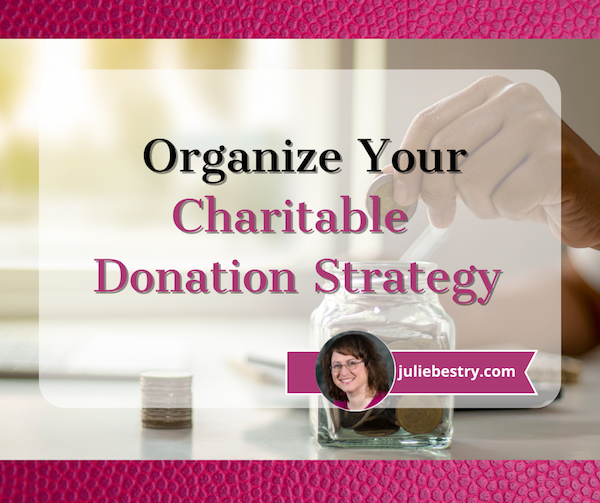
Every day last week, your email inbox was filled with Black Friday and Cyber Monday notifications. But starting today and throughout the month, you’ll probably notice an influx of requests for charitable donations.
This starts with tomorrow’s Giving Tuesday, a unified movement that:
…unleashes the Power of Radical Generosity around the world. GivingTuesday reimagines a world built upon shared humanity and generosity.
Our global network collaborates year-round to inspire generosity around the world, with a common mission to build a world where generosity is part of everyday life.
Whether it’s making someone smile, helping a neighbor or stranger out, showing up for an issue or people we care about, or giving some of what we have to those who need our help, every act of generosity counts, and everyone has something to give.
The term “radical generosity” is defined as the concept that the suffering of others should be as intolerable to us as our own suffering. This may seem like an odd topic for an organizing blog, but I believe that organizing your efforts can allow radical generosity to reinvigorate the delight of giving.
THE UNIVERSALITY OF CHARITABLE GIVING
In Judaism, the concept of tikkun olam means “to repair the world,” and refers to the notion that people have a responsibility to improve the world through acts of kindness and social justice. Judaism also has the concept of tzedakah, commonly used to mean charity, but more fully is explained by the notion of making the world a more just place.
Though I am no expert on other faiths, I do know that charity is an important tenet throughout faith practices. In Christianity, it’s reflected in 2 Corinthians 9:7, “Each one must give as he has decided in his heart, not reluctantly or under compulsion, for God loves a cheerful giver.” Islam notes that the prophet Muhammad said, “Charity does not decrease wealth” to point out the value to the benefactor as well as to those who receive kindness.
In Hinduism, “There is none other who does greater good than the one who removes the hunger of those in a difficult situation, helpless, weak and disturbed.” And Sikhs believe in the concept of sewa, which means “selfless service,” helping others without expecting any reward or personal gain.
Of course, donating money (and goods) is not a concept specific to any one religion, or indeed any religion at all. Ideas such as charity and mutual aid (where a community shares and exchanges resources and services to help one other) can be found in every nation and at every income level. People make donations in their houses of worship and to their schools, to strangers on the street and to well-known non-profits.
Donating money (as well as volunteer time and skill) is a great way to model your values to your children and to others in your community. You could limit round-robin gift exchanges at work or among your extended family and work together to donate funds or effort to non-profits or causes that reflect your highest good.
So yes, thoughtful giving is good (and good for you), but the requests for giving can be overwhelming.
Just like how the clutter of too many possessions in a household can paralyze someone and prevent them from knowing what to do next, a mailbox or inbox cluttered with charitable donation requests can be problematic, particularly during the holiday season from Thanksgiving through the New Year, when everyone is focused on gratitude and lovingkindness.
But if you woke up to seventy-three charitable requests today, you might not be feeling very grateful, loving, or kind. I get it.
THE CHALLENGES OF CHARITABLE GIVING
There are a variety of obstacles people face when inundated with charitable requests.
Stress
- Being inundated by a flood of donation appeals — Non-profits know that you’re in a giving mood (or are feeling pressured to be in a giving mood). People are accustomed to donating at the end of the year, whether for religious, social, or tax reasons, so the donation campaigns behind mailers and emails and social media requests are part of the design.
- Pressure and guilt — It’s common to feel obligated to respond to every request with a donation or gift, even when it exceeds one’s budget or doesn’t align with one’s values. Nobody wants to feel selfish, but it’s important not to give more of yourself than you can afford.
Fears about security
- Increases in frauds, hoaxes, and scams — Sometimes, “charitable” requests come from bad guys using guilt trips and names just similar enough to real charities that it’s common to worry about whether your gift will get to anyone except a thief’s pockets.
- Validity of a charity — Even if a charity is “real,” even if it’s well-known, it doesn’t necessarily mean that a sizable portion of the funds raised will get to the expected recipients. Sometimes a shocking percentage of those donation funds go toward administration, chief executives, advertising, and anywhere but where you’d hope it would go.
Financial anxieties
- Budget constraints and unrealistic goals — At this time of year, our wallets pulled in different directions, like taffy. You’re likely to want to earmark funds for holiday gifts, meals, and travel, on top of regular expenses, but it can be tough to find the Benjamins for donations. Being overly ambitious with our charitable giving leads to the same kind of anxiety as when we’re overly ambitious about gift-giving to friends and family. It feels good in December, but when our January bank and credit card statements arrive? Ouch!

- Unplanned donations — There’s a reason you hear financial advisors talking about planned giving. Planning is organized, and when you are organized, you feel in control. When unexpectedly faced with an in-person appeal for a donation, the emotion of the experience combined with social pressure (on top of financial pressure) can prompt you to spend more than you can comfortably do.
Emotional kerfuffles
- Family disagreements — You thought the political arguments at the Thanksgiving table were stressful? Imagine trying to come up with a plan for family giving when the members of the family are of two minds regarding who is “deserving” of family donations. If one person wants to give to the NRA and another to support of LGBTQ+ teens, but the funds need to come from one couple-owned or family-managed source, sparks may fly.
- Decision fatigue — The sheer volume of need can be overwhelming. Everyone wants your money, and so many charities and worthy causes requesting donations, it’s often difficult to decide which ones to support.
- Charitable burnout — People who donate regularly may feel resentful from the ever-increasing demands during the holiday season.
- Compassion fatigue — Let’s face it. We’re human. Constant reminders of those who are hungry, abused or victimized, troubled, or struggling can become wearying, especially for those who already struggle with some of the harder emotions of the holiday season. While such requests often remind us to feel grateful for what we have, it’s not unusual to feel guilty for not feeling quite so grateful about our own struggles.
OVERWHELM COMES FROM LACK OF PRIORITIZING, PLANNING, AND ORGANIZATION
Over the past 23 years I’ve worked as a professional organizer, one of the constant holiday-time struggles my clients face is what to do about all of the charitable donation requests. Several years ago, I worked with a client on her backlog of important documents and papers. We were making great progress until I arrived one day to find her agitated. She admitted that she’d been “hiding” some papers because they were so stressful for her to think about.
In a room we’d never entered, there were desks, tables, chairs, and a bed, and a variety of other horizontal surfaces covered in envelopes — most of which had never been opened — all seeking donations! There were multiple years of requests!
At first, this sweet woman had just given a few dollars to everyone who asked, but that just led to more and more requests. (I’m not saying that non-profits sell their mailing lists, but yes, some non-profits sell, or at least “rent” their mailing lists. It’s ethically questionable, so before you give, you may want to read a charity’s privacy policy regarding whether they will share donor information without prior consent.)
The client and I started by eliminating all requests from prior giving seasons, then deleted duplicates (and triplicates). Then we developed a strategy that works for most people.
START WITH YOUR BUDGET
Just as some people prefer to say they are on an “eating plan” rather than a “diet,” feel free to think of this as a giving plan, rather than a budget. The idea is to set boundaries you can live with, as it makes no sense to donate so much to end hunger that you will be eating ramen noodles every day to make up for your economic shortfall!
Consider these factors:
- How much can you reasonably afford to give? This requires first having a handle on all of your fixed and variable expenses.
- Would you like to allocate a percentage of your monthly budget for donations? Do you prefer to tithe, set aside a fixed dollar amount per month, or pick some other percentage approach?
- Do you prefer to give an annual gift or arrange monthly contributions?
- If you choose monthly donations, do you want to donate to the same charity every month, or multiple charities but during different months?
- Do you want to set aside extra money (in monthly petty cash) for unexpected, ad hoc requests by organizations or individuals? (You might choose to keep a stash of gift cards for grocery stores or restaurants to give to unhoused or struggling folks you come across, rather than giving cash, to prevent them from becoming victimized by thieves.)
- Does your company offer an annual charitable donation match? If so, taking advantage can stretch your donation dollars!
FOLLOW THE MONEY
You will want to track your donations to make it easier to file your taxes and take all possible deductions.
If you respond to mailed requests for donations, you can write a note on the donation letter, stating how much you donated, on what date, by what method (check number or which credit card). Put that in your tax prep folder for the current year. When/if you get an official letter from the charity thanking you for your donation, match it to the corresponding note and staple it.
If you tend to make donations online, be sure to print a copy of your receipt as a PDF (if you want to keep records electronically) and maintain a donation folder on your computer or in your cloud storage. (You could also print receipts on paper and put them in your tax prep folder; just don’t double-count donations that appear in digital and print form.)
Of course, you can also use financial apps, budgeting software, or spreadsheets to track your charitable contributions. The more money you donate, or the more complex and numerous your donations, the more cautious you will want to be to keep these records for tax purposes. But tracking your donations is about more than just taxes.
In the heyday of magazines, as soon as you’d renew a subscription, you’d start getting reminders to renew again. The more subscriptions, the harder it would be to realize you were being prompted so often that you were subscribing more than once every twelve months. Well, with charities it can be much the same thing. Keep a written record of when you’ve donated to make sure you’re not donating more often than you planned.
CHOOSE YOUR CHARITIES, DON’T LET THEM CHOOSE YOU
Professional organizers often talk with clients about the dangerous power of advertising and in-store displays. We can be going along, thinking we’re doing great with our spending plans and then all-of-a-sudden we are sucker-punched by an enticing commercial or a product display. We didn’t plan to buy it. We didn’t need it. But oops, we got it.
Those donation emails and envelopes may as well be shouting: “This offer is available for a limited time only. Operators are standing by!” but the truth is that non-profits are always in need of money. You may get dozens of requests for donations in December, but your contributions will be no less valuable, life-saving, or appreciated if sent three or six months down the line. Unless you have a very specific need for making a very specific dollar amount of donations before the end of the calendar year, don’t let yourself feel pressured.
Decide on your giving goals in advance. Make this a giving plan.
Prioritize Your Values First
When you try to downsize a closet on your own, you might pick up one article of clothing and ask yourself “keep or set free?” (whether “set free” means toss or consign or donate or use as a rag). A straight-up yes/no choice can be difficult. But if a professional organizer asks you to first pick your ten favorite pieces from your closet and set them aside, it will be much easier to start evaluating your less-loved pieces.
Similarly, if you’re facing a mountain of charitable giving requests, choosing yes or no may feel like you are saving or damning the recipients of each non-profit. No wonder you’re stressed!
So, start by prioritizing the causes that align most closely with your values. For example, those might be:
- education
- the arts
- health/medical
- hunger
- animals
- children
- the environment
- faith communities
- disaster relief
- international relief
- social causes
- political causes
- at-risk communities
- marginalized communities
Once you’ve identified a general cause area that matters to you, you can narrow your focus. You can determine whether you want to donate locally to keep funds in your community or donate to a national effort with a more powerful network of resources.
Research Potential Charities
You do not have to reinvent the wheel. There are some excellent resources for evaluating non-profits and explaining how they rank on transparency, impact, and mission alignment. Consider:
Charity Navigator

Charity Navigator has been around for almost 25 years, and has rated 225,000 charities. Their ratings focus on the “cost-effectiveness and overall health of a charity’s programs, including measures of stability, efficiency, and sustainability.”
GuideStar

Candid’s GuideStar focuses on non-profits in the United States. Search to verify a charity’s legitimacy, learn whether contribution will be tax deductible, view up to three years of a non-profit’s IRS Form 990, read revenue and expense data for the current fiscal year, and learn about a charity’s CEO, Board Chair, and Board of Directors.
BBB Wise Giving Alliance

Give.org, the Better Business Bureau’s Wise Giving Alliance, generates reports that address all of the issues a donor might want to consider, including governance, finances, results reporting, transparency, and appeal accuracy
Charity Watch

Charity Watch, originally founded in 1992 as the American Institute of Philanthropy (AIP) claims to be the only independent charity watchdog in the United States. Charity watch notes that they “dive deep into charity audited financial statements, tax filings, state solicitation filings, and other information so we can let you know how efficiently a charity will use your donations to fund the programs you want to support. CharityWatch exposes nonprofit abuses and advocates for your interests as a donor.”
GiveWell

Rather than focuses only on financials, GiveWell conducts “in-depth research to determine how much good a given program accomplishes (in terms of lives saved, lives improved, etc.) per dollar spent.”
If you decide you want to focus on local charities, you’ll need to do more of your own legwork. For example, if you want to support a local shelter, food bank, or other community initiative, read the website, research who sits on the board of directors, and see where local news media has covered the impact of these charities.
Concentrate on local efforts that focus on long-term community solutions and have a record of efficient use of funds and a history of measurable results.
DEVELOP A DONATION STRATEGY
Once you know which causes are meaningful to you, you can delete or discard donation requests from causes that aren’t high on your list of values.
Yes, really.
Charitable causes are important, but not all causes have to be equally important to you, just as they need not be equally important to all individuals. You get to pick what you value.
Once you identify the causes you value, you can research the specific charities in each.
Let’s say eliminating hunger is important to you. It’s possible you’ll get requests from Feeding America (a nationwide network of more than 200 food banks), the World Food Programme (an international organization within the United Nations that provides food assistance worldwide), No Kid Hungry (providing grants to schools and partners to end child hunger), Meals on Wheels (working to end hunger and loneliness among the elderly), etc.
- Collect all the requests that come in via mail or email in a “holding area” until you’re ready to research them.
- Research the charities to see which appeal to you the most.
- Decide the number of charities to which you will give.
- Pick the frequency of your donations: one time or recurring?
- Divide your giving budget by the number of donations.
- Donate in a way that works for you.
- Record and track your donations for tax purposes. (Save receipts and acknowledgment letters in your paper or digital files)
- Evaluate amounts and charities annually.
For example, might decide to give to one national charity, once per year, in an amount that feels generous to you. Conversely, you might pick four of these charities and give once per quarter.
Alternatively, you could set up a monthly payment to one (or more charities) on your credit card, but you’ll want to revisit that plan annually to make sure the charity still fits your values.
Or, this process of reviewing your values may make you turn your attention to local concerns. You could still give small donations to one or more of the charities that fits you criteria, but then you could contact a local elementary school and offer to pay all outstanding meal fees. In many school districts, children whose families are behind on their lunch fees are unable to get hot lunches and are given cold lunches that make them a target of bullying. In other districts, they simply get no lunch at all. Hungry children cannot learn.
You could pick an amount to pay toward students’ outstanding lunch debt each month, or pool resources with your colleagues or neighbors to pay off those debts once or twice per year.
This is merely one example. You can make lots of donations in December to lots of charities, and then skip the rest of the year. You can pick twelve charities and give equal amounts, one per month, all year, and revisit the charities you’ll choose each year. Or you can mix-and-match local and national donations as you see fit.
The key is to mindfully research, plan, and track your giving so that it allows you to feel generous (and lucky to be able to help) rather than overwhelmed by charitable request clutter and anxious about the entire experience.
LIMIT DONATION ANXIETY
Creating a giving plan and sticking to it (at least for one year) will allow you to eliminate the excess requests before they pile up, but there are additional things you can to do keep from feeling like a Grinch.
Limit the solicitations that come your way.
If you are getting too much donation request mail or email — which, again, is really just (earnest) advertising, it’s OK to click to unsubscribe from the email or call to opt-out of the mailing lists.
Alternatively, you can use a dedicated email address (like PaperDollDonations@gmail.com) whenever you make donations. That way, you only need to check that address when you’re looking for donation confirmations for tax purposes, or when you’re in the mood to actually look at the plethora of mail sent your way. But it never has to hit your main inbox.
Let Go of the Guilt
Just because you receive address labels does not obligate you to make a donation to a charity, just as receiving a holiday card from a distant acquaintance does not obligate you add the individual to your card list. Don’t let them turn advertising techniques into a free ticket on the Guilt Trip Express. Use your brain — then give from the heart.
Learn to say “No” gracefully. Just as you cannot keep everything you ever bought or were gifted, you cannot donate to ever cause that asks.
To increase your comfort with saying no, prepare a mental (or written) script for declining requests.
Remind yourself (and if you wish, explain to others) that you have a planned giving strategy. You have organized your giving to ensure that your efforts are mindful and value-driven. You can, if you wish, give an ad hoc donation, but you can also just say you’ll be happy (if you will be) to consider a donation in your next giving cycle in 2026.
Finally, remember that you need not always give money. Donating your possessions, time, and service to non-profits can be even more valuable than the amount of money you could afford to donate.
Speaking of volunteering, we are sometimes asked to donate our time and effort to worthy causes at the holidays when our schedules least allow us to help. (Also, many popular volunteering activities, like serving meals at shelters, are booked quickly during the holidays.) But guess what? Shelters and food kitchens need volunteers year-round! Just as money is needed just as much on July 25th as on December 25th, our support of our neighbors, in our schools, in faith communities, and in standing up for others is always needed, no matter the season.
Happy Giving Tuesday (and Giving Season). Intentional and organized giving is rewarding. Build a sustainable, organized habit of giving and you will feel more in control of your finances, less stymied by paper and digital clutter, and less likely to feel burned out.
Keep the spirit of giving alive in a way that uplifts you.
What to Do With Print Photos You Do — and Don’t — Want

Let’s talk about photos.
No, not the 4th of July selfies where you look gloriously happy. I’m not even talking about digital photos at all, but prints.
If you’ve only ever taken photos with a phone, did you know that’s only been possible since 1999? Babies born the week the iPhone was invented are about to be seniors in high school. And before then, there were digital cameras, but really only since the 1990s.
For most of photographic history, photos were printed on paper. (And yes, if you’ve got a headache thinking that I even need to explain this, I feel your pain, fellow oldster.) This means that many of our houses are filled with envelopes and boxes and albums of print photos, some of which aren’t very good.
DIGITAL VS. ANALOG PHOTOS: WHY IT’S HARD TO DISCARD ONE AND NOT THE OTHER
You may be wondering what the big deal is. If you’ve only (or mainly) got digital photos, you’re probably happy to let them sit there on your phone or in cloud backup. Maybe you make slide shows to display on a digital photo frame or create photo books, but they probably aren’t bothering you.
People enjoy their digital photos because we’re all used to immediately deleting bad shots. Mom is squinting into the sun or our midriffs look bulge-y? Hit that trash can icon! We’re generally comfortable with deleting items from our photo stream.
And yet, as I’ve seen time and again with friends and clients, the prospect of throwing out any print photo seems to make people wince.
We're generally comfortable with deleting items from our photo stream, but the prospect of throwing out a print photo seems to make people wince. Share on XPeople second-guess themselves when faced with a photo that resembles nothing so much as 99% thumb with a blurry background.
Recently, a client and I flipped through a stack of his late father’s photos from the 1950s. They ranged from high school dance snapshots to Korean-era war era Army training. All were shot in black-and-white, and while several were fairly crisp and well-lit, many were blurry, and either washed out or too dark.
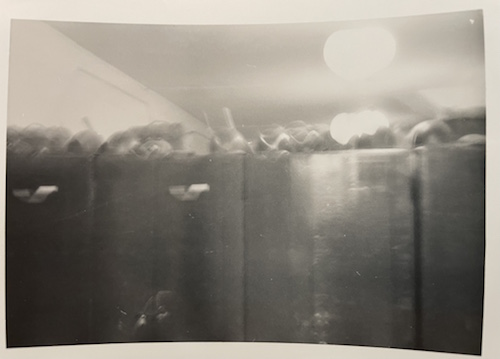
Client’s mystery photo circa 1956
This one was not only impossible to identify (boxes? filing cabinets? Is that Mr. Potato Head?). His father, who’d meticulously noted the participants in most photos, had just written, “Beats me” on the reverse.
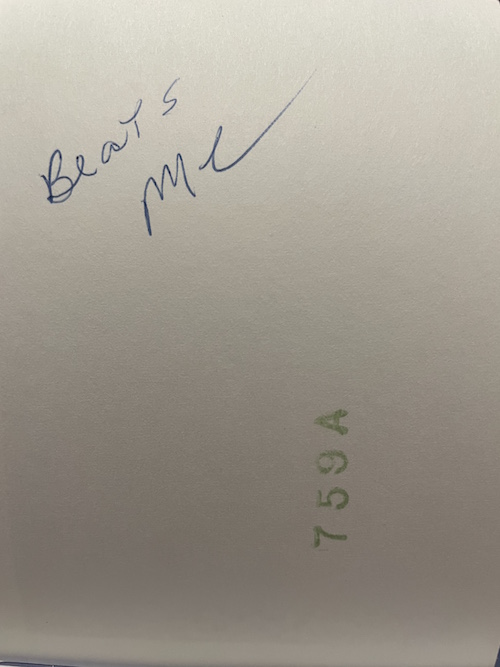
The reverse of the mystery photo: “Beats Me”
For six decades, this print stayed in the stack, sandwiched between personally and historically relevant photos. Why do we do this?
Maybe it’s because we’re completists. We have the negatives and we worry that if we throw out the print, the numbers won’t match up, and someone, some day, will be upset by the imbalance.
Perhaps it’s because we don’t trust our own judgment. Compared to the high quality photography we’re capable of now, old shots are pretty poor. We’ve got thirty-seven identical photos of the lilac bush in the corner of the front yard from 1978. We’re sure they’re useless. But what if we’re wrong? What if these shots are artistic? What if we discard the one that’s actually the best?
Fearing our own taste (or lack thereof) we keep bad prints, even though we wouldn’t hesitate to prune these from our photo streams right after snapping them.
Or maybe it’s just because analog things feel more real to us than digital things? Thus, the loss of the tangible seems real, whereas the digital even doesn’t seem real in the first place, so letting go doesn’t bother us.
If I make the decision to give away a hardcover because I know I’ll never read it again, I often feel disconcerted, even though this is what I do professionally. When a borrowed library ebook automatically gets returned (unread or even only partially read), I just shrug. There’s no distress. They’re just not real to me. I suspect for some of us, it’s the same with digital photos. But prints?
HOW TO ORGANIZE THE PRINT PHOTOS YOU DO WANT: A CHEAT SHEET
Some print photos are like a warm hug.

Paper Doll and big sister, spring 1968
Handling an embarrassment of print photo riches is a labor of love. You must:
- Separate the wheat from the chaff and eliminate what you don’t want. (See next section.)
- Sort photos, whether chronologically or by event types (birthdays, holidays, etc.) or themes.
- Determine how you’ll store print photos:
- Photo Albums — Unlike the bulky flip albums of the sixties or the sticky “magnetic” albums of the 1980s, today’s experts recommend albums with acid-free, lignin-free pages to prevent photos from yellowing or deteriorating, and photo corners or sleeves to hold the print photos in place without any adhesive touching them.
- Photo Boxes — Step up from shoe boxes and seek out acid-free, lignin-free photo boxes that store the photos vertically (and safely), with labeled dividers and indexes to keep prints organized and categorized.
24 Smart Ways to Get More Organized and Productive in 2024

Happy New Year! Happy GO Month!
January is Get Organized & Be Productive (GO) Month, an annual initiative sponsored by the National Association of Productivity & Organizing Professionals (NAPO). We professional organizers and productivity experts celebrate how NAPO members work to improve the lives of our clients and audiences by helping create environments that support productivity, health, and well-being. What better way to start the year than creating systems and skills, spaces and attitudes — all to foster a better way of living?!

To start GO Month, today’s I’m echoing Gretchen Rubin’s 24 for ’24 theme that I mentioned recently, and offering you 24 ways to move yourself toward a more organized and productive life in 2024. There are 23 weekdays in January this year, so if you’re feeling aspirational and want to conquer all of these, you can even take the weekends off as the last item is a thinking task rather than a doing task.
I broke these organizing and productivity achievements down by category, but there’s no particular order in which you need to approach them, and certainly you don’t need to accomplish every one on the list, in January or even all year. Jump in and get started — some only take a few minutes.
PUT LAST YEAR AWAY
1) Make many happy returns!
Did you know that shoppers will return $173 billion in merchandise by the end of January? Chances are good that you (or someone for whom you oversee such things) got gifts that need to be returned.
Don’t put it off. The longer you wait, the more clutter will build up in your space, and the more likely you will be to suffer clutter-blindness until the return period has expired. Most stores have extended return policies during the holidays, but they can range upward from 30, depending on whether you have a gift receipt.
The Krazy Coupon Lady blog reviews the 2024 return deadlines for major retailers. She notes that you’ll get your refunds faster by returning items to the brick & mortar stores rather than shipping them back. You’ll also save money, because some online retailers charge a restocking fee.
2) Purge your holiday cards.
While tangible greeting are getting fewer and farther between, you probably still got a stack. Reread them one last time, and then LET THEM GO.
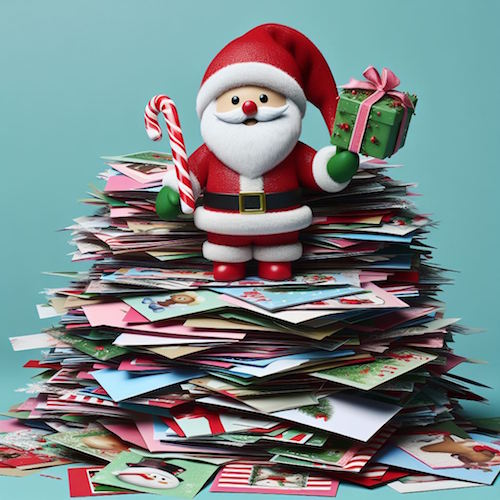
Did Hallmark or American Greetings do the heavy lifting, and the senders just signed their names? Toss them into the recycling bin. Paper Doll‘s grants you permission to only save cards with messages that are personal or resonant.
If they don’t make you cry, laugh, or go, “Ohhhhh,” don’t let them turn into the clutter you and your professional organizer will have to toss out years from now when you’re trying to downsize to a smaller home! It’s a holiday message, not a historical document; you don’t transcribe your holiday phone conversations and keep them forever, right?
The same goes for photos of other people’s families. You don’t have to be the curator of the museum of other people’s family history; let them do that.
3) Update your contacts.
Before you toss those cards, check the return addresses on the envelopes and update the information in your own contacts app, spreadsheet, or address book.
Next, delete the entries for people you’ll never contact again — that ex (who belongs in the past), that boss who used to call you about work stuff on weekends (ditto), people who are no longer in your life, and those who are no longer on this mortal coil.
If you don’t recognize the name of someone in your contacts, Google them or check LinkedIn (is it your mom’s doctor? your mechanic?) and if you still don’t know who it is, you’re obviously not going to be calling or texting them. Worst case scenario, if they text you, you can type back, “New phone, who dis?”
BOX UP YOUR INBOXES
4) Delete (most of) your old voicemails.
How often do you return a call only to hear, “The voicemail box is full and is not accepting messages. Please try again later.” When someone calls you and requests you call them back but their voicemail is full, it’s frustrating because it makes more labor for you.
Do you assume that it’s a cell phone and text them? (I believe texting strangers without permission is a breach of etiquette.) Plan to call back later? Assume that they’ll see the missed call and get back to you, starting another round of phone tag? ARGH!
Dial in to your voicemail and start deleting. Save phone numbers for anyone you’ll need to contact and log anything you may need to follow up on. But unless you’re saving a voicemail for legal purposes or because you can see yourself sitting in an airport, listening to a loved one’s message over and over (cue sappy rom-com music), delete old voicemails.
If you’ve got a landline, clear that voicemail. If you’ve still got an answering machine, how’s the weather in 1997? Yeah, delete old messages.
Smith.ai has a great blog post on how to download important voicemails (from a wide variety of phone platforms) to an audio file. Stop cluttering your voicemail inbox!
5) Clear Your Email Inboxes
Start by sorting your inbox by sender and deleting anything that’s advertising or old newsletters. If you haven’t acted on it by now, free yourself from inbox clutter! Delete! Then conquer email threads, like about picking meeting times (especially if those meetings were in the past).

Take a few minutes at the end of each day to delete a chunk of old emails. To try a bolder approach, check out a classic Paper Doll post from 2009, A Different Kind of Bankruptcy, on how to declare email bankruptcy.
6) Purge all of your other tangible and digital inboxes.
Evernote has a default inbox; if you don’t designate into which folder a saved note should go, your note goes somewhere like Paper Doll‘s Default Folder. Lots of your note-taking and other project apps have default storage that serves as holding pens. Read through what you’ve collected — sort by date and focus on the recent items first — and either file in the right folders or hit delete!
Walk around your house or office and find all the places you tend to plop paper down. Get it in one pile. (Set aside anything you’ll absolutely need in the next few days to safeguard it.) Take 10 minutes a day to purge, sort, and file away those random pieces of paper so that you always know where they are.
HIT THE PAPER TRAIL
7) Embrace being a VIP about your VIPs.
You need your Very Important Papers for all sorts of Very Important Reasons. If the last few years have proven anything, it’s that life is unpredictable, so we need to find ways to make things as predictable and dependable as possible.
Yes, putting together essential paperwork isn’t fun. It’s boring. But you want it to be boring. The more boring your vital documents are, the more it means there will be no surprises for your loved ones in troubling times (like during and after an illness, after a death, while recovering possessions after a natural disaster) or even when you’re just trying to accomplish something like getting on an airplane.
Start with these posts, then make a list of any document you already have (and where it is), and another list of what you need to create, and plan meetings with your family and a trusted advisor to set things in motion.
How to Replace and Organize 7 Essential Government Documents
How to Create, Organize, and Safeguard 5 Essential Legal and Estate Documents
The Professor and Mary Ann: 8 Other Essential Documents You Need To Create
Paper Doll’s Ultimate Guide to Getting a Document Notarized
Paper Doll’s Ultimate Guide to Legally Changing Your Name
A New VIP: A Form You Didn’t Know You Needed
8) Create your tax prep folder now so you’ll be ready for April 15th.
Do you toss non-urgent mail on top of the microwave? Might those important 1099s and 1098s and 1095-A and W-2s get lost? Don’t lose deductions, pay more taxes, or get in trouble with the IRS!
By the end of January, you’ll start getting tax documents in the mail. Pop them in a folder in your financial files or in a dedicated holder like the Smead All-in-One Income Tax Organizer.
Paper Doll’s Thanksgiving Week Organizing and Productivity Buffet
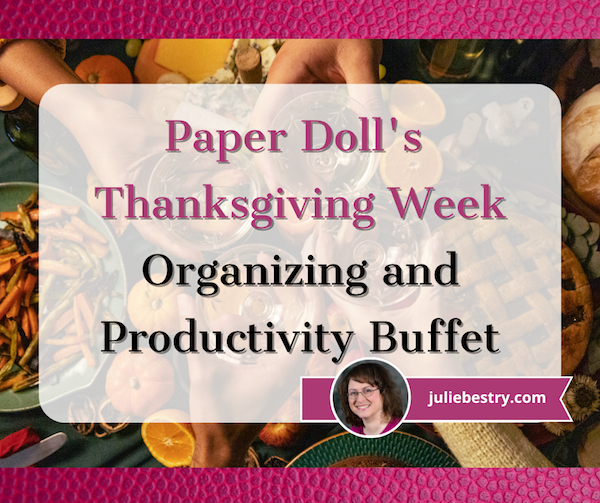
Whether you’re getting ready to go over the river and through the woods, hosting a Thanksgiving celebration of your own, or stuck (in an airport or at home) with too little to do, today’s post is for you.
I’ve created a Thanksgiving buffet from which you can take some tastes and figure out what you like. Decide for yourself whether to categorize any of these as appetizers, entrées, sides, or desserts. There’s nothing serious to require your deep attention, so just nibble as though you were sneaking through the kitchen on your way to watch the parade.
GRATITUDE AND A FOLLOW-UP ON THE CAR THEFT
If you read my August post, Organize to Prevent (or Recover From) a Car Theft, you know that I was a victim of the Kia Boys, young miscreants across the United States who steal KIAs and Hyundais, not for financial gain but for “street cred” or thrills. It’s my philosophy that almost anything bad from which you recover makes a good anecdote (or blog post), but the lesson of preventing car thefts and recovering from them is one I’d have preferred to research online rather than personally experience.
The indignities of being a victim of theft did not stop with the recovery of my little red PaperDollmobile. Due to a turf war between towing companies, miscommunication at the body shop, an utter failure of professionalism on the part of someone we’ll call the Jerky Insurance Dude, and a series of back-ordered parts (mostly due to the mass of Kia and Hyundai thefts nationwide), it took two months for my car to be repaired and returned.

Just a few weeks ago, the federal judge who initially refused to approve the $200 million class action settlement against Kia and Hyundai because it wasn’t supportive enough of victims has acknowledged the revisions to the settlement and approved it. It will likely be years before we victims see those compensatory funds (almost certainly be reduced by attorney and court costs), but the resolution is something else for which I can be thankful.
Meanwhile, if you haven’t read the original post, or if you’d like to hear more of the updates, or if you just prefer a good chatty tale, friend-of-the-blog Dr. Frank Buck recently had me on his podcast in an episode entitled From Chaos to Clarity: A Professional Organizer’s Car Theft Journey.
Frank and I discussed many of the concepts in my blog post, but also expanded upon teh experience. We talked about handling the unexpected, and how to deal with shock of a situation but still capture the essential information in order to survive and get to the other side. Professionally and personally, Frank and I can attest to the essential role of good note taking during any emergency or catastrophe.
If you watch the podcast on video, above, and please leave a comment or “like” on Frank’s YouTube page. Or, if you’re driving somewhere this week and need to drown out the “Are we there yet?” whines punctuated by kicks to the back of your seat, you can listen to my episode of Frank’s podcast on Apple Podcasts, Google Podcasts, Spotify, Overcast, Castbox, and pretty much wherever you get your pumpkin-spiced podcasty goodness.
HOW TO SHOW GRATITUDE FOR OUR BOUNTY
“There is no product or service more ecological, sustainable and recyclable as the one we do not use.”
— Philippe Bihouix, engineer and author of The Age of Low Tech: Towards a Technologically Sustainable Civilization
This quote, included in Sunday’s Cool Tools Lab’s Recommendo newsletter, was certainly well-timed.
What a perfect way to show gratitude for the bounty in your life by using the week ahead to identify what you’re not using or wearing and earmark those items for donation.
Thanksgiving is an ideal time to discuss with your children the concept that not everyone has as much, and help them consider the toys and games they’re no longer enjoying. It’s a great way to be responsible to the planet, their fellow humans, and their own home.
And what better way to teach your children than by example?
Last Friday, I gave one of my signature speeches detailing all the reasons why it’s difficult to let go of possessions. I talk about how we sit on our “Buts” (one T) as in, “I’d let go of it…but it was expensive.” Or, “I’d let go of it, but it was a gift.” In part of that presentation, I noted that one of the big “buts” in letting go of excess is “But I want to find the perfect home before letting go.”
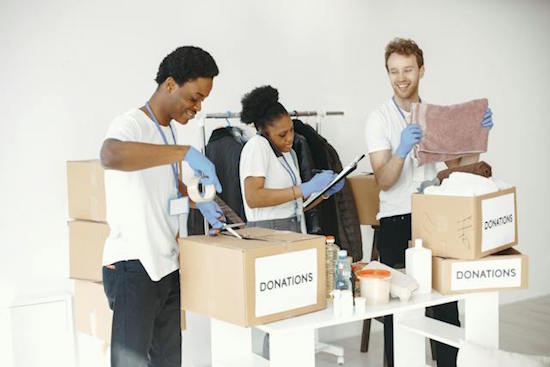
People Working at Donation Center Photo by Gustavo Fring via Pexels
We hate spending the time, money, and effort to keep what we don’t want or need, but we hate the idea of “wasting” perfectly good items more, as if languishing in OUR basement is a better fate for something than ending up with (an unknown) someone whose worth we can’t know or judge.
So, we decide that as soon as we find the perfect place for an unused table to go, we’ll send it on its way, but either we don’t know about available resources (like a furniture bank or Habitat for Humanity’s Restore) or we never go all the way from making the decision to actually getting it out of our homes. Take comfort that whether you recycle, donate, or sell, letting go of what you never use has three benefits. It means a good home for the item, joy for the new owner, and more space for you.
As we say in professional organizing, done is better than perfect!
GET CRAFTY ABOUT REDUCING YOUR CRAFT STASH
Speaking of getting rid of excess for purposes of sustainability, my fabulous friend and colleague Janice Simon of The Clutter Princess brought my attention to a nifty option for all of you crafty (and aspiringly crafty) folks.
Destashify is your resource for letting go of the excess cloth- and needlework-adjacent craft supplies you have on hand. It’s a bit of crafting thrift shop. In their words: Destashify is dedicated to keeping sewing, quilting, knitting, crochet, and other wearable art supplies out of landfills.
Destashify will sell, recycle, or donate your excess crafting supplies to individuals or organizations who will make use of you letting them instead of letting them pile up in the corner.
Obviously, if you actively work on your crafts, nobody would encourage you to stop. But if you have piles of these kinds of supplies, either in your own space or the space of someone you have responsibility for maintaining, Destashify offers a few nifty options.

Destashify, Filtered for Purple Yarn
Sort through your materials and collect any unwanted fabric, patterns, yarn, trim, and notions. If you have books, magazines, or DVDs on sewing, quilting, or related crafts, as well as patterns or even machinery (like sewing machines, accessories, and software), add them to your outgoing stack. Now, you have two options.
Sell Your Craft Supplies via Destashify
If you sew, quilt, knit, or are otherwise a “fiber artist,” you can destash (that is, declutter your stash), start a side hustle to fund your hobbies or life, or expand any craft-related existing business with a new outlet.
- Create a Destashify seller’s account and list your items for sale.
- Fulfill orders made through the Destashify site.
- Receive payment through either Venmo or Paypal.
Destashify charges no up-front costs to sellers. If you sell supplies via Destashify, they keep $1 + 15% of the remaining product subtotal. Beyond that, they charge no extra listing fees or payment transaction fees. If any of your items fail to sell, they won’t charge you anything for the listing (or re-listing). Buyers pay one flat fee for shipping, and sellers retain 100% of the shipping fee, but are responsible for the actual shipping costs.
Donate Your Craft Supplies to Destashify
If you donate your craft supplies, Destashify will pay for the shipping! (Note: Destashify is not a 501(c)(3), so you can’t deduct the value of your donation on your taxes.)
Destashify may donate your donations to organizations, like schools, or sell to fund operations. As when you donate anything, make sure your supplies are in good, clean condition. They can be related to: sewing, quilting, knitting, crochet, weaving, embroidery, tatting, upholstery, and home décor. Gather them up in a box (or boxes) and then:
- Click on the “contact us” link at the bottom of every page of the Destashify page and tell them that you want to donate.
- Once you provide your shipping address and phone number, Destashify will send you prepaid shipping labels (with the information you provide as the label’s return address).
- Include the height, width, and depth dimensions, as well as the weight of each package you want to send. (Limit your shipping box dimensions to under 19 inches.)
They require a minimum of one yard of apparel fabrics or 1/4 yard for quilting fabrics. Leather, suede, and fur are accepted, as is yarn. Notions include doohickeys like thread, elastic, and grommets, while fastenings are, as you might guess, things that let you fasten clothing, like snaps, buttons, or zippers. Destashify will also accept small tools, like rulers, scissors, and awls.
However, they are unable to accept donations that are heavy or oversized, requiring excess storage space or egregious shipping costs. So, please don’t donate big storage or furniture items like cabinets or sewing tables, nor heavy machines like sewing machines or sergers. (You can list them for sale through Destashify, though!)
Watch two of the Destashify-ers talk about craft donation hauls here.
Destashify is a young venture, so they currently only support U.S.-based sellers; they are able to ship to buyers in Canada and the United Kingdom.
Finally, if your craft area is nicely pared down and organized, and you’re interested in buying from Destashify, just click on any menu and use the left-side panel to filter for things like color families, fabric types, fibers, patterns, garments and garment types, weights, and more.
PUT THE KIBOSH ON COAT CLOSET KERFUFFLES
Longtime readers of the blog know that I’m not one for recommending unnecessary products, and I don’t usually mention products that are too far afield from organizing your paper, information, and productivity. And I definitely avoid recommending products before they’re entirely on the market. However, when things come across my TikTok feed that make me sit up and take notice, I want to share them with you.
Swedish inventor and YouTuber Simone Giertz has developed Coat Hingers, and no, that’s not a typo. Giertz’s Kickstarter was seeking $50,000 to manufacture foldable hangers to allow for clutter-free storage in shallow closets and narrow spaces. In the first two days, she not only hit her goal, but exceeded it! Now, with 26 days remaining in her Kickstarter month, she’s already garnered $255,984 in pledges from 1940 backers aspiring to own the product.
Unlike the kind of foldable hangers designed to be used in luggage, Giertz found no solutions for folding hangers meant to actually be hung in closets, particularly shallow ones. So, she created her own, developing prototypes of hinged hangers.
You just put your article of clothing on the hanger, fold at the hinge, and now you’ve got the ability to store the shirt (or whatever) in half the depth.
Whereas traditional hangers measure about 17 1/2 inches, horizontally, Coat Hingers fold to take up just 9.3 horizontal inches. The hingers are made of stainless steel hangers with injection molded acetal hinges for durability.

Supporting Giertz at this point is a pricey, but if you’re in a small space and are likely to be there a while, it’s worth considering. One Coat Hinger is $20, and a dozen are $75.
Because Coat Hingers need to be a certain distance from the wall, they recommend that in lieu of off-the-shelf (no pun intended) closet rods, you make the rods in their kits, which come in four different color schemes (charcoal, white, red, and green). The shelf kit is $270, while the small bracket kit is $135 and the large is $200. The shelf kit and large bracket kit come with two dozen Code Hingers; the small bracket kit comes with one dozen.

All Coat Hingers come with a set of silicone stoppers that slide along the diagonal arms of the hanger to keep items with low necklines or thin straps from sliding off of the hanger.
Unfortunately, Kickstarter videos aren’t shareable. (Why?! Social sharing would bring in so many more backers?) However, Giertz’s YouTube channel has a great video on how her product came to be that will give you a good sense of what she’s creating.
(Did you notice that it’s pronounced coat hinge-er, accenting the hinge, rather than coat hing-er to sound like hanger?)
When I was in graduate school, I lived with six other students in my program in a scary green Addams Family-esque house with squirrels in the attic. Due to the luck of the draw, I got one of the larger bedrooms, but the closet was minuscule, slightly smaller than a telephone booth, with the sole rod positioned on the diagonal. Hanging clothes in that shallow a space was almost an impossibility, as was keeping any kind of order. I would have loved Coat Hingers back in 1990!
DE-STRESS THE HOLIDAY SEASON FROM THE START
Thanksgiving is the official start of the holiday season, which means it can also be the start of the stressed-out, exhausted season as well. I’ve got two resources for you for keeping your season on an even keel.
First, the theme of Janet Barclay’s November Productivity and Organizing Carnival is Stress-Free Holidays. It includes 15 posts from my fabulous colleagues for helping you deal calmly with planning and organizing your season and getting the self-care you need.
Then, you might want to pick up a copy of my classic season-smoother, Simplify the Season and Save Your Sanity so that you can thrive, and not merely survive during the upcoming holiday season.
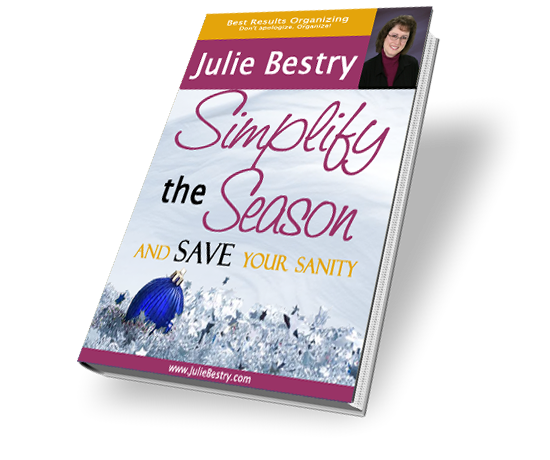
Are you so frazzled by mid-December that your nerves start to feel like tangled Christmas lights?
Have visions of sugarplums been replaced by nightmares of long lines and traffic jams?
Does that Thanksgiving turkey remind you of a time bomb, ticking down to the big day in December?
If so, Simplify the Season and Save Your Sanity may be exactly what you need.
PLAN FOR A SANE RE-ENTRY NEXT WEEK
Heading back to work after a long Thanksgiving weekend can be overwhelming, and it can be tempting to try to barrel your way through the work. However, back in October, we talked about the importance of taking time away from your desk to refresh, whether short-term or long-term.
Take a Break — How Breaks Improve Health and Productivity
Take a Break for Productivity — The International Perspective
After you revisit these posts, you may want to read this piece from The Muse, Take Five: 51 Things to Do When You Need a Break at Work.
I’d explored a variety of break options, but some readers mentioned that they often feel guilty taking breaks that “looked” lazy, as if doing healthy things for your body, brain, and spirit somehow lacked worth. (Remember Paper Doll telling you this: you are not your job or your role. Your worth does not come from what you do. It’s innate to who you are!)
The genius of this Muse post is that it offers some fun suggestions, links, and resources for digging deeply into categories of breaks that still accomplish something, in case you’re still working on accepting yourself even when you’re not entirely in worker-bee mode. The categories are:
- Energizing
- Brain-Boosting
- Social
- Productive (It won’t surprise you that this is my favorite category of tips!)
- Career-building
- Relaxing
- Downright Distracting
My favorite, given that we’ll have just come out of Thanksgiving, is #18:
Send a thank you note to someone who’s helped you out recently—your assistant who’s gone above and beyond or a co-worker who proofread a report for you. It doesn’t even have to be something big—in fact, bonus points if it’s not.
And with that, kind readers, I thank you for reading, commenting, and sharing. May you and your families and friends have safe travels and a happy, healthy Thanksgiving.
Paper Doll Wraps Up, Declutters, and Updates 2020

It’s been quite the year. “Unprecedented,” you might say. (Or, better yet, let’s not say. How about we purge that word from our vocabulary?) Before we turn the calendar page to 2021, there are a few additions and updates for the posts you read (or might have missed) over the past year.
PANDEMIC PRODUCTIVITY
The Now Normal: When the New Normal Changes Quickly
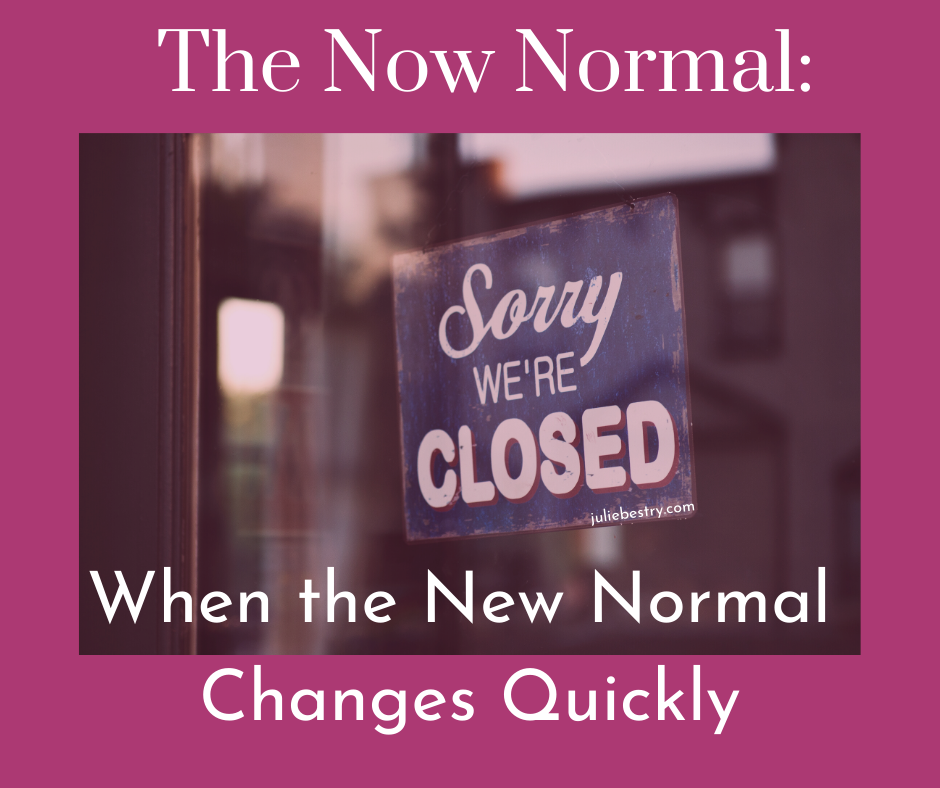
Back in March, none of us knew what the next nine months would bring. I’d acknowledged the difficulty of being at home, whether that meant working from home, home-schooling, or dealing with family and their foibles 24/7, and noted that at least, to some extent, we’d get used to it, or at least we’d have to get used to the “Now Normal” of things constantly changing and us not getting used to things. Little did we know how long (how very, very long) we’d be getting used to things constantly changing. I gave you all permission (as much as anyone needs permission from random internet bloggers) to be OK with not being OK.
Now, on the cusp of 2021, there’s light (in the form of a vaccine) at the end of this tunnel. But I suspect things will never go back to exactly where they were. Remote work had already been increasing (by 173% between 2005 and 2018); 2020 gave companies the impetus to make this a more permanent option. Companies that had believed workers could never be as productive when working remotely found that the opposite was true. According to research collated by Apollo Technical:
- Performance can improve up to 13% when working remotely (in a quieter, more convenient workspaces)
- Remote work yielded greater worker satisfaction
- Remote workers spend 15% less time avoiding work tasks
- Anecdotally, once supervisors trust the work-from-home approach and stop micromanaging, productivity increases.
This doesn’t mean we can extrapolate only good things to come out of more people working from home. Even once children and life partners are no longer in the home/work space, the distractions of household tasks (especially for women) will likely adversely impact productivity, and research indicates that productivity may take a hit due to prolonged lack of social interaction (especially for extroverts, like moi).
Some workplaces will stay 100% remote; others will return to traditional venues; and I suspect many employees will demand greater flexibility, and companies will want to consider the reduced overhead associated with smaller (or no) dedicated offices. The only thing we know for sure is that things will continue to change, and we’ll have to be nimble, accepting that the sand will keep shifting under our feet. As L.P. Hartley once wrote, “The past is a foreign country; they do things differently there.”
The only thing we know for sure is that things will continue to change...As L.P. Hartley wrote, 'The past is a foreign country; they do things differently there.' Share on XPaper Doll’s Ultimate Guide to Organizing a Virtual Field Trip

This post proved to be one of the most popular during the early pandemic. Organizing our days to include breaks, including virtual day trips to escape monotony, became a necessity this year, and rarely a week went by when a reader did not email or tweet or post to tell me about other cool virtual field trips.
Friend of the blog Janet Barclay knows that Paper Doll is a consummate Jane Austen fan, and forwarded Celebrate Jane Austen’s Birthday With a 360-Degree, Interactive Tour of Her House, and from there it was a quick hop, skip, and virtual jump to the Emma Thompson-narrated Twelve Days of Christmas special. There are also paid live virtual tours of Jane Austen’s House from Home, trails, and exhibitions. (Two live tours in January each go for £5, or about $6.78).

Discovery Education has developed a variety of live and on-demand, family-friendly interactive field trips. Each is free and includes a companion guide with hands-on learning activities! Take your kids to “visit” the Johnson Space Museum in Houston, see the cars of the future, hobnob with polar bears in the Tundra, and so much more. Whether you need a virtual field trip to break up winter vacation, quell home-schooling doldrums, or reverse just too little play time, Discover Education is a delightful addition to the options in my post.
Perhaps you binged too much of The Crown and need a reality check? Take a virtual tour of Buckingham Palace. Prefer a different venue? How about the Taj Mahal, the White House, or the Vatican?
Virtual Museums started an interactive map of the world’s museums available to virtual visitors. (Create an account to track and rate your visits.) From the Canadian Museum of Human Rights to South Korea’s National Museum of Modern and Contemporary Art to the mysterious fossils of the Graz Natural History Museum in Austria, new field trips for grownups are appearing all the time.
And if you need the the kind of field trip that takes you away from the hubbub, Escapista may be to your liking. Escapista has developed a manifesto to explain its approach to selecting opportunities for immersive meditative experiences, from pausing by a snowy river to Norway’s “Slow TV” experience of ten hours on a train. (Click the speaker icon to turn on the audio.)
Be sure to organize time in your life to relax and to learn for fun.
Does Anybody Really Know What Time It Is? 5 Strategies to Cope With Pandemic Time Dilation

There’s an irony of mentioning time dilation between two long weekends marked by Christmas and the new year. I’ve lost count of how many people have told me they checked for the mail on Friday or took the trash to the curb on the wrong day.
In the original post, I explained why our body clocks became so borked during our quarantine and recommended five strategies, with LOTS of tactical suggestions, for keeping everyone from becoming unstuck in time:
- Put structure in your life.
- Enhance novelty.
- Create vivid sensory clues for the passing of time!
- Get what you know you need! (Daylight, sleep, exercise, and for those of you who’ve had the same pair of sweats in rotation since St. Patrick’s Day, get dressed!)
- Take a technology break.
As a professional organizer and productivity coach, my job is to help people get more out of their time. But efficiency isn’t everything. In a year like we’ve had, and going forward, some daydreaming and navel-gazing preserves sanity. If you find yourself losing track of time too often, add in a bit of structure to your day and use technology to get a quick “beep-boop.” But do give yourself permission to enjoy the one small benefit of this year, living by your natural body clock.
Organize Your Health: Parental Wisdom, Innovation, and the New Time Timer® Wash

Don’t touch your face. Wear a mask. Wash your hands. It’s good advice, so listen to your mom. Listen to mine.
READING RENEWAL
12 Ways to Organize Your Life to Read More — Part 1 (When, Where, What, With Whom)

I’m not the only embracing tips for reading more. Oprah, the ultimate book club leader, may have ended her print magazine, but the December issue offered up 20 Simple Ways to Read More and Enjoy More Books in 2021. (Personally, though, I preferred my take on developing a reading nook. What do you think, readers?)
12 Ways to Organize Your Life to Read More — Part 2 (Reading Lists, Challenges & Ice Cream Samples)

Want to read more in 2021? You’ve got a bounty of options for finding recommended reading lists. One of my favorites is the NPR Book Concierge. (Find annual suggestions going back to 2013.)
If, instead of looking for a specific title, you want to find a 2021 reading challenge that, well, challenges you, opportunities abound, including:
The Uncorked Librarian (Most intriguing suggestion: read a book set on a train.)
Modern Mrs. Darcy (This year, it’s not just reading prompts, but an entire interactive kit for creating your personalized reading life!)
GirlXOXO Master List of Reading Challenges (While I’ll skip the challenge to read mysteries with cats as main characters, there are certainly lists galore for every taste!)
Meanwhile, who would be up for a Paper Doll reading challenge to embrace books on organizing and productivity?
How To Make Your Reading Time More Productive With Book Summaries

My coverage of book summaries focused on non-fiction. Unless you’re in 11th grade English class (sorry, kids), you probably don’t want summaries of novels. However, you can get ice cream tastes of fiction, to see if you like an author’s style.
- Most people are familiar with Amazon’s “Look Inside” feature, which allows you to click a link above the book cover and read a handful of pages. But did you know that many Kindle books have “Send a free sample” link so you can preview chapters? Check in the browser version, not the app, below the “purchase with one click” section and above the “add to list” button.
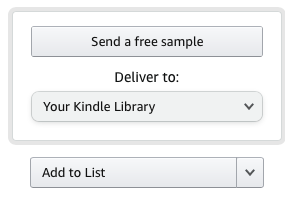
- You can also get a free audio sample. Check for a link under the book cover.

- Literary Hub has daily offerings of novel excerpts. Click on the book cover you want to try, and the resulting page provides short author bio and a selection from the novel. Titles range from new releases, like Mrs. Murakami’s Garden, to reprints of classics, like Betty Smith’s Tomorrow Will Be Better. (Literary Hub also has short stories excerpted from short story collections.)
PAPERWORK DECLUTTERED
Organize for an Accident: Don’t Crash Your Car Insurance Paperwork

In April and May, due to much of the country quarantining and people driving far fewer miles, many insurance companies offered 15%-25% premium rebates to customers.
While rebates largely disappeared by June, that doesn’t mean you should be paying full price if you’re still staying close to home. For example, if your workplace has decided to go “permanently remote,” and you no longer have a commute, it’s worth contacting your insurance agent about potentially lowing your premiums now that you are regularly driving less each week. One option insurance companies are exploring is vehicle telematics, little “black boxes” that keep track of your speed, mileage, and precision at accelerating and decelerating, and report back to the insurance company. Safer drivers get better rates.
Similarly, if your college-age student is not currently on campus and is attending school remotely (from your home), that means your car is in the driveway most of the time, not states or time zones away. Review your situation with your agent for the greatest number of discounts.
Paper Doll On Narwhals, Fake News, and How To Get A REAL ID

Everything in the post is still accurate except for the enforcement deadline. Due to COVID, the federal government delayed enforcing REAL ID by one year, to October 1, 2021. Remember, as of next October, if you don’t have Real ID-compliant identfication, you won’t be able to board a domestic flight or enter federal courthouses or restricted federal facilities, like military bases, nuclear power plants, or the White House.
Paper Doll Says The Tax Man Cometh: Organize Your Tax Forms

The forms are the same, but a few the rules have changed. Kiplinger’s Magazine covers a few dozen of the Tax Changes and Key Amounts for the 2020 Tax Year.
ORGANIZING ADVICE, PLAIN AND SIMPLE
The Truth About Celebrity Organizers, Magic Wands, and the Reality of Professional Organizing

As you head into 2021 armed with resolutions to get more organized, please review my counsel in this post. I stand by my word that there are no magic wands!
And in a future post, I’ll have more to say about advice from celebrity organizers with regard to organizing by color. Here’s a preview:
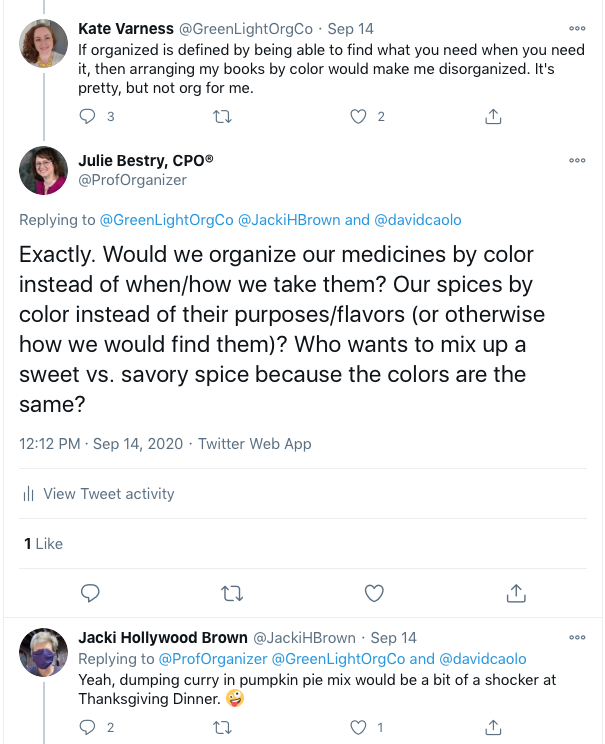
(Readers, if you like curry in your pumpkin pie, feel free to tell Jacki directly!)
Organize Away Frustration: Practice The Only Good Kind of “Intolerance”

This is the perfect week for you to take note of whatever frustrated you during the holiday season: a light system with too many broken bulbs, an artificial tree that has seen better days, a sense of obligation to send holiday cards to people who haven’t so much as liked one of your Facebook posts in a decade. Stop tolerating what doesn’t work for you, and if you don’t know the solution, seek help to find one.
Paper Doll Peeks Behind the Curtain with Superstar Coach, Author & Speaker Leslie Josel
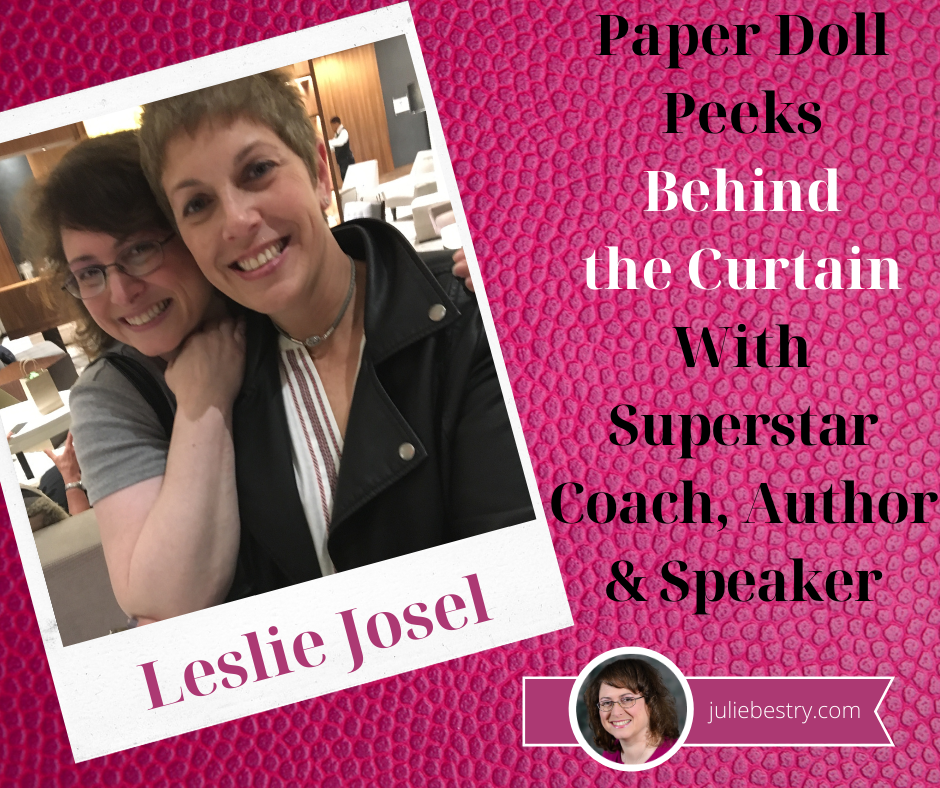
Our talk about 1980s sweaters may have been dated, but discussion of student procrastination is not. This fall was the first semester that was 100% in COVID times; even stellar students struggled, and “taking an incomplete” has become a common refrain. If you have (or are) a student, Leslie’s How To Do It Now, Because It’s Not Going Away should be on your bookshelf.
Organizing in Retrospect: A Confessional Look Back at 2020
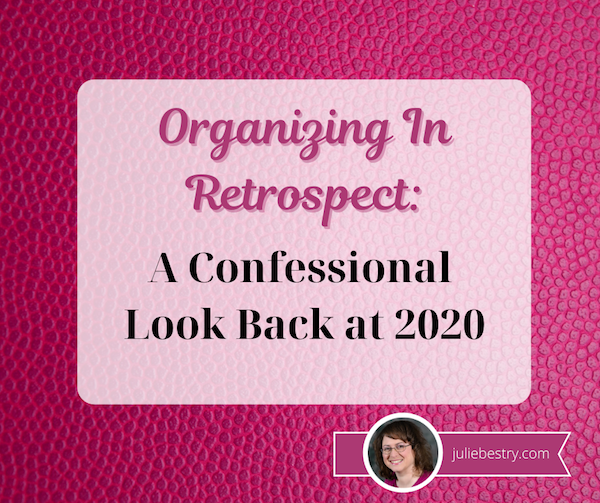
Writing this post, I realized I accomplished more than I realized. (Which would have been easy; when people asked what I’d been doing this year, I was often at a loss for words. “Missing my mom, my friends, and my travel plans, eating too much cheese, and craving Chinese food” seemed like an ineffective response.
This quiet lull before the new year is the perfect time to pull out your calendar and scan your To Do lists. Take notice of your achievements; in a year like this, it’s easy to forget small (and even not-so-small) victories. Ask your friends and loved ones to report back on the successes they recall from your year. Tally them up. Whether you use this in your next performance evaluation at work or just to buck up your self-esteem, remember that surviving this year intact is an accomplishment!
CLUTTER-FREE HOLIDAY GIFTS
In a Downton Abbey-themed post a few years ago, I told you about Give Back Box, a program whereby you could gather up the items your new holiday presents made redundant and easily ship them off to charity. This year, especially, when a touch-free donation option is especially useful, I encourage you to explore Give Back Box.
Clutter-Free Holiday Gifts for the Weird Year of 2020 (Part 1): New Twists on Old Favorites

For those of you looking for gifts of cooking classes, two highly praised options came in after deadline: King Arthur Baking‘s impressive calendar of interactive, online cooking and baking classes, and Milk Street‘s live-streamed and recorded, self-paced virtual classes. (If you give a cooking class gift to someone with whom you live, you get to eat the homework!)
Clutter-Free Holiday Gifts for the Weird Year of 2020 (Part 2): Giving Well, Giving Back

In addition to tangible gifts that give back to others, I wrote about charitable giving in your recipient’s name. Due to COVID, new tax laws let most taxpayers deduct cash donations of up to $300 made by December 31, 2020 when filing taxes in 2021 – even if you don’t itemize. (Note, this is a “per return” deduction, meaning married couples get the same $300 deduction as singletons. Consult your tax advisor.)
Clutter-Free Holiday Gifts for the Weird Year of 2020 (Part 3): Organizing Yourself & Others

Finally, I hope one of the gifts you give yourself is the time and opportunity to keep reading organizing and productivity advice here at Paper Doll.
Thank you, my dear readers, and have a happy, healthy 2021!







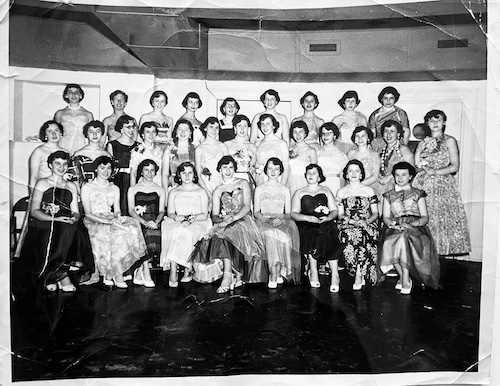





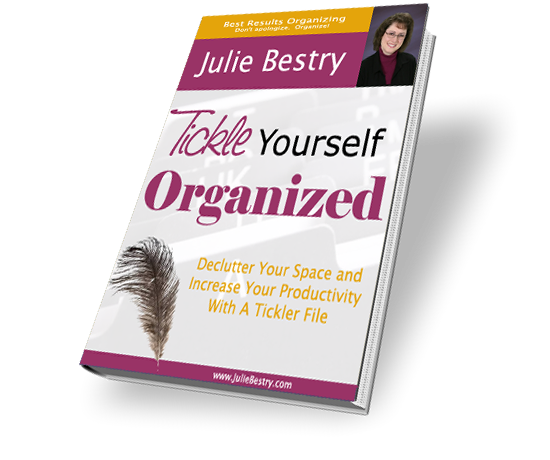





Follow Me